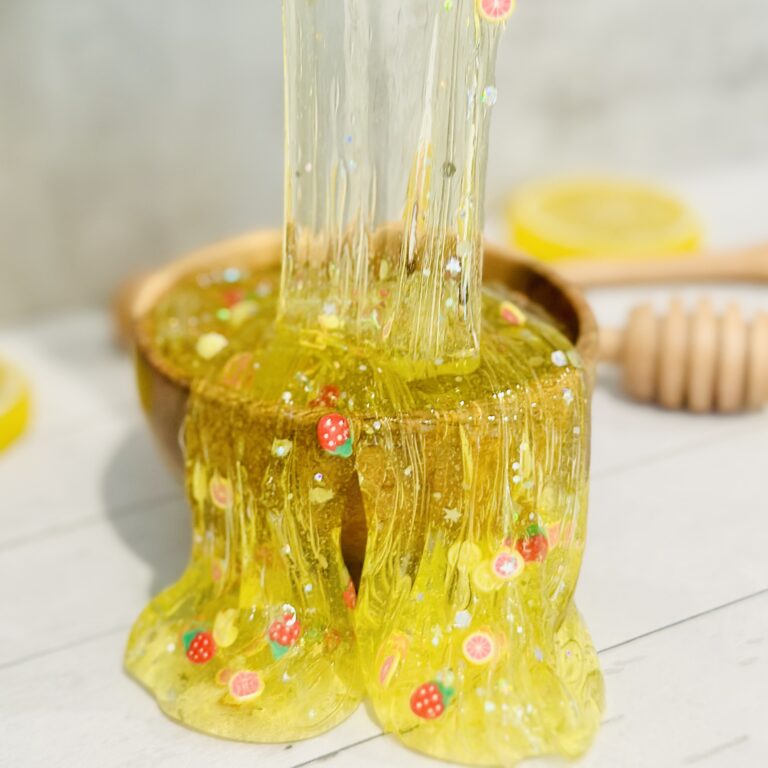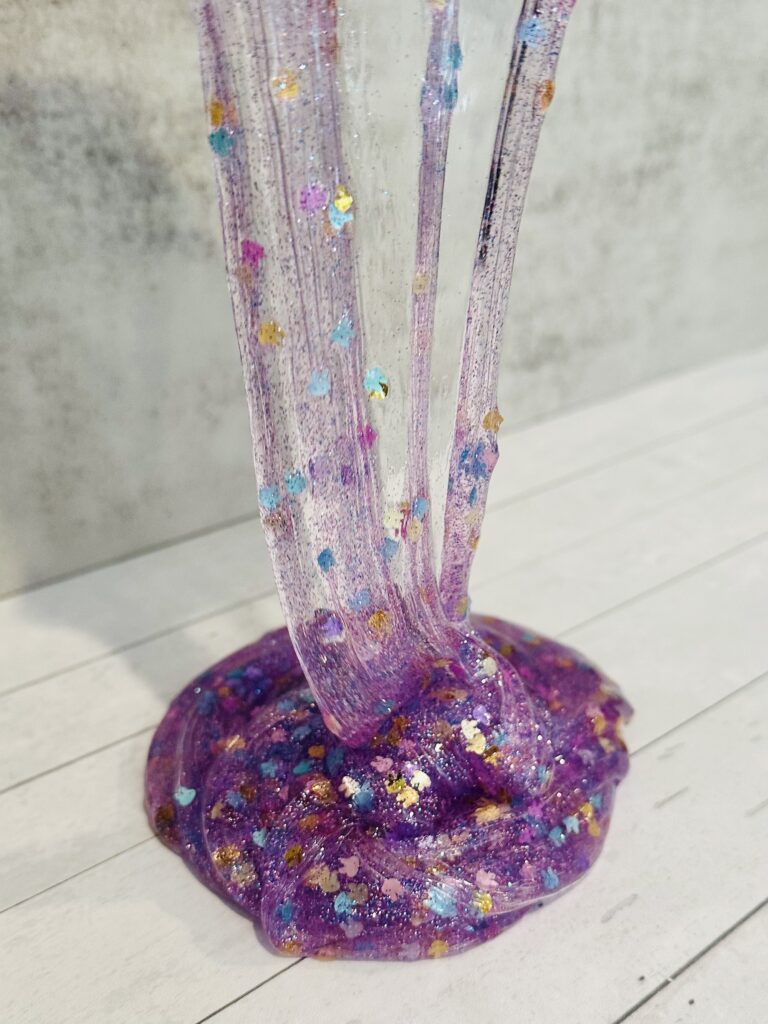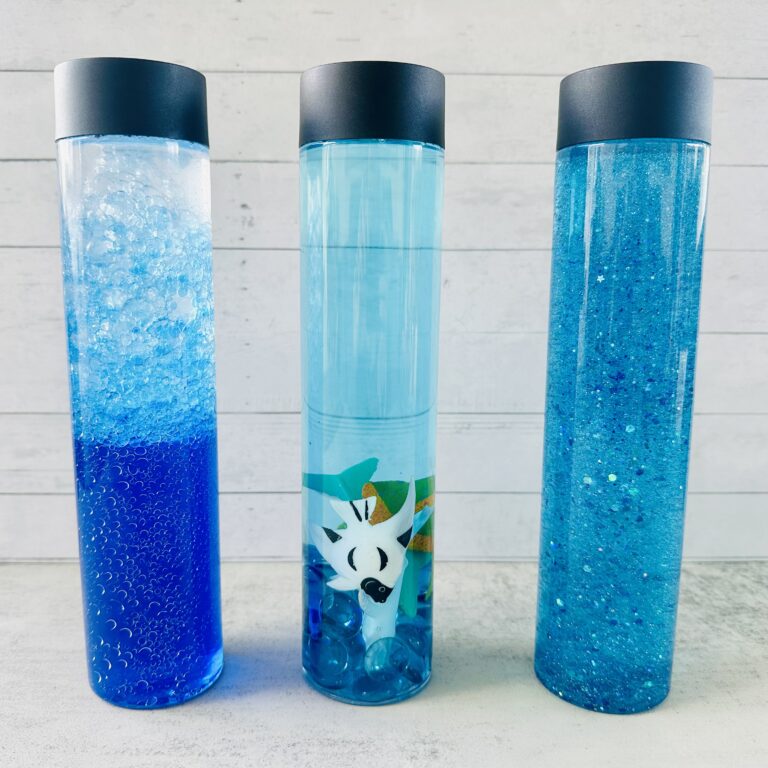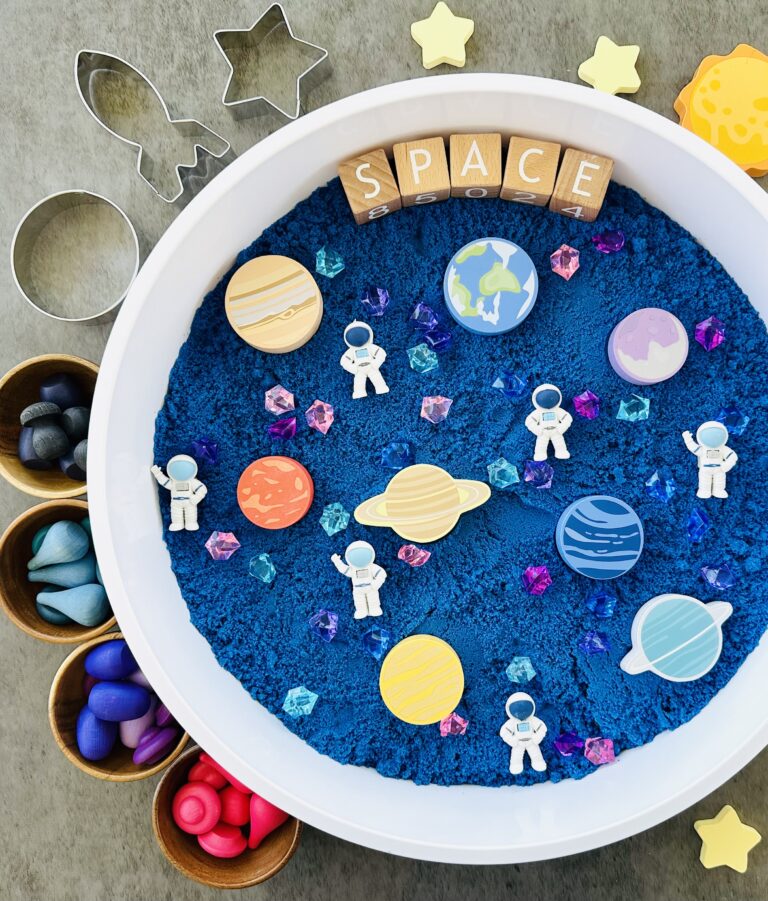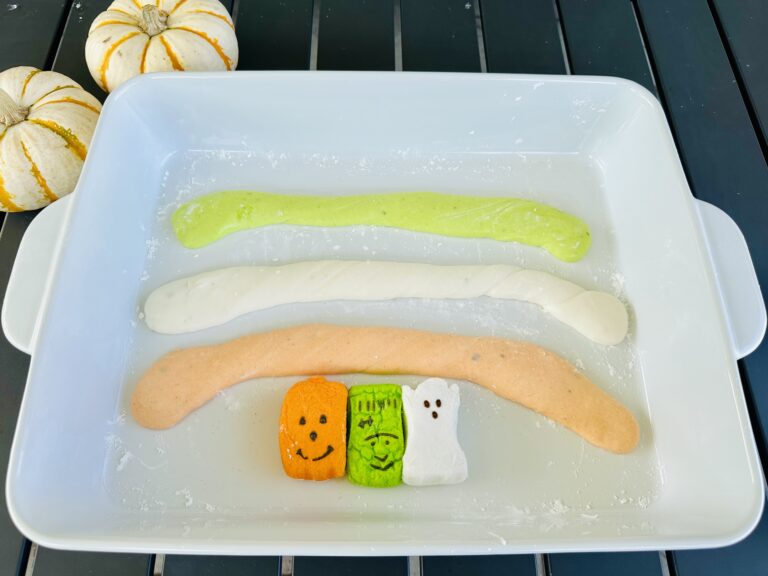How to Dye Chickpeas for Sensory Play
Learn how to dye chickpeas for sensory play and bring vibrant, colorful fun to your sensory bins! Perfect for creative play!

Always supervise children during sensory play. See full disclaimer here. This post may contain affiliate links, which means I may earn a small commission if you make a purchase through these links, at no extra cost to you. As an Amazon Associate, I earn from qualifying purchases. I only recommend products I personally use and love! You can read more about my disclosure policy here.
Let me tell you something—once I figured out how to dye chickpeas, it changed everything about sensory play in my house. Seriously, it’s a game-changer! If you’ve ever wanted a sensory bin that’s colorful, fun, and easy to make, you’re in the right place. Trust me, you’ll want to try this at home.
I used to wonder how people made those gorgeous, vibrant chickpeas. I mean, are they using soggy canned chickpeas? Spoiler alert: they’re not. They’re using dried chickpeas! I grabbed a few bags from the store one day, and I’ve never looked back. Now, every chickpea sensory bin I make looks like a rainbow explosion, and my kids love it.
Here’s the best part—it’s super simple to do. Whether you’ve got food coloring or liquid watercolors lying around, you can make this work. And guess what? You can do it with your kids! They’ll love watching the dye magically change the chickpeas colors as they shake the bag. Plus, it’s a fun sensory activity all on its own.
How to Dye Chickpeas (AKA Garbanzo Beans)

What You’ll Need
To start, all you need are a few simple supplies you probably already have lying around.
- 2 cups dried chickpeas (also called garbanzo beans)
- Liquid watercolors or food coloring (both work beautifully!) Liquid watercolors create bold, vivid hues, but are not food-safe. While food coloring offers softer, more translucent shades, and are non-toxic and food-safe.
- 1 tsp vinegar, rubbing alcohol, or hand sanitizer (optional but recommended) I’ll explain the pros and cons of each below.
- Plastic Ziplock bags or a container with a lid
- Parchment or wax paper, or baking sheet (for drying)
Instructions
Here’s how you can easily dye plain dried chickpeas and transform them into vibrant, colorful sensory bin fillers in just a few simple steps:
1. Start with Chickpeas
Pour about 2 cups of dried chickpeas into a large Ziplock bag or a container with a lid.
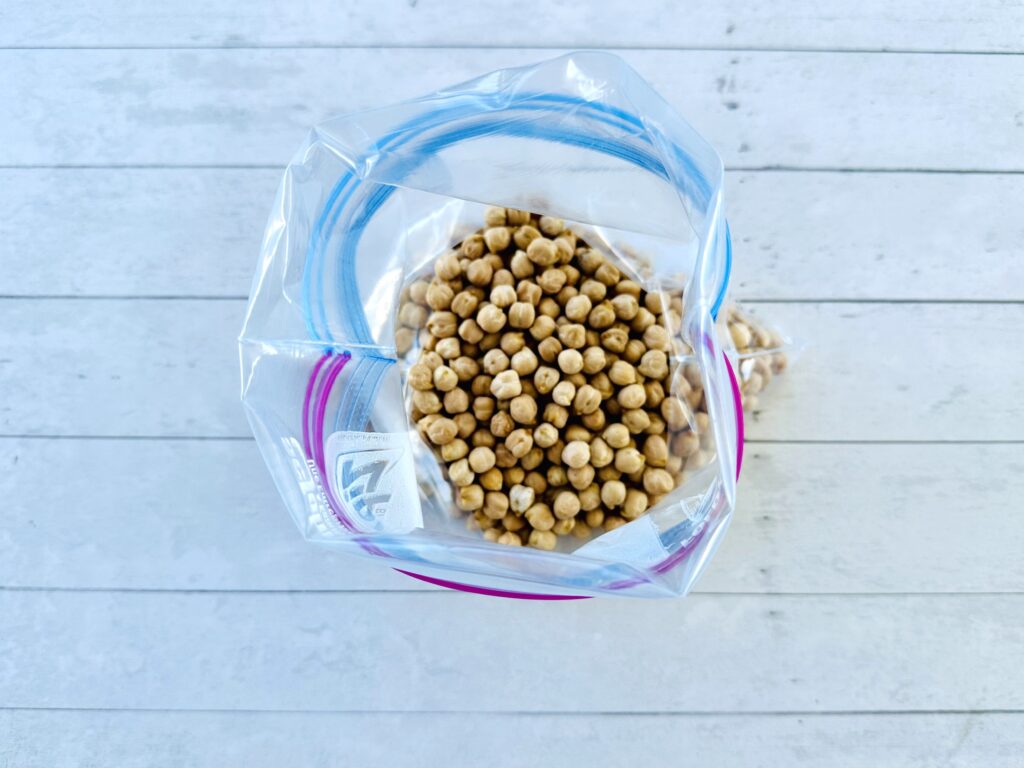
2. Add Your Color
Add about ½ tablespoon of liquid watercolors or 10-15 drops food coloring. You can always add more if you want the colors brighter! Add 1 teaspoon of vinegar, rubbing alcohol, or hand sanitizer—this optional step helps the color spread more evenly, so you can use less. If you’re doing multiple colors, just repeat this process with separate bags for each color.
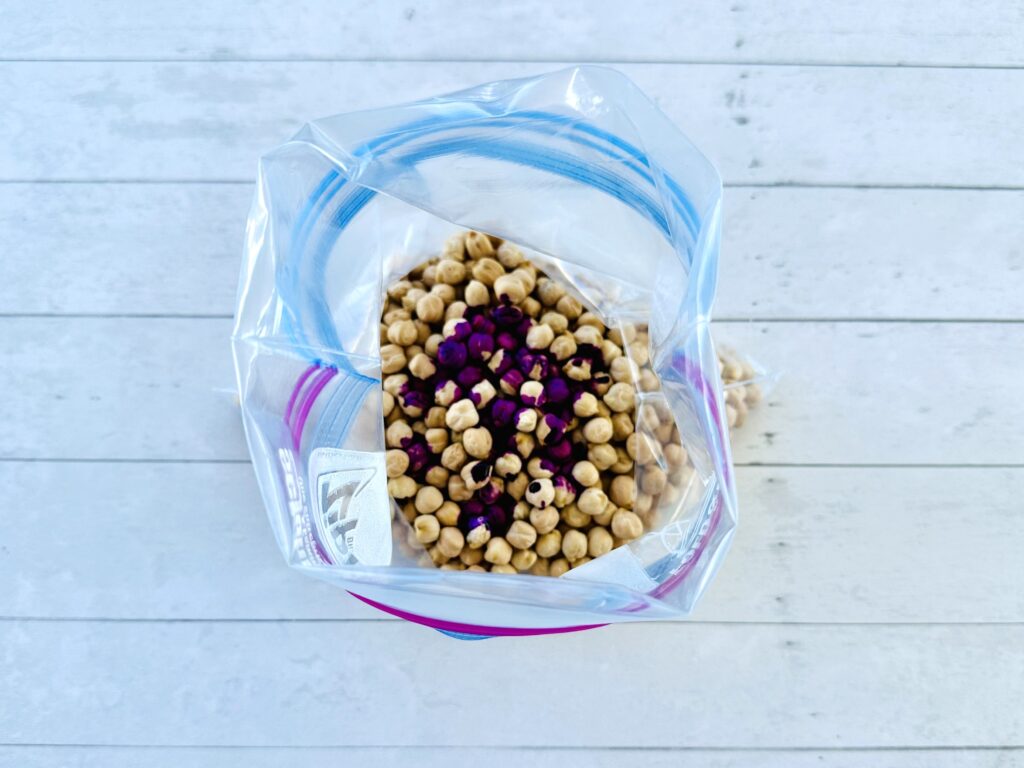
3. Shake It Up
Seal the bag and give it a good shake! (This is a great part to do with your kids—they love watching the chickpeas magically change color.) You can also mix them with a spatula if you’re using a container with a lid.
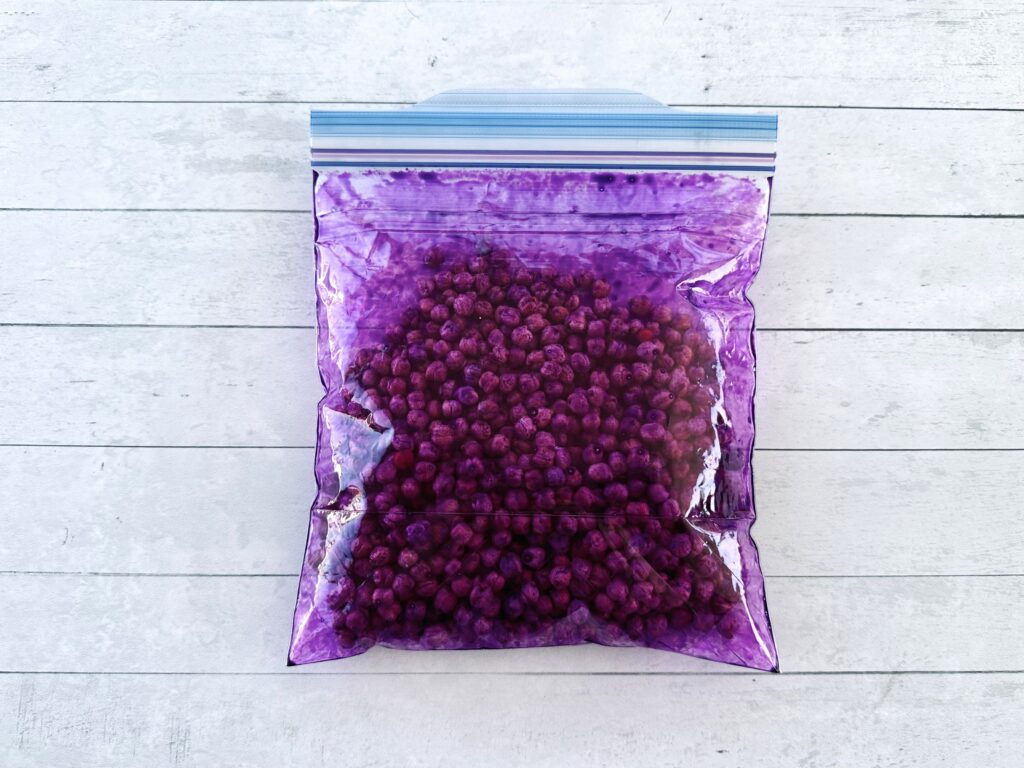
4. Dry Time
Spread the colored chickpeas out on parchment paper in a single layer to dry. Liquid watercolors dry almost instantly, but if you’re using food coloring, it might take a little longer. If you want, give them a little stir while they’re drying to make sure they’re not sticking together.
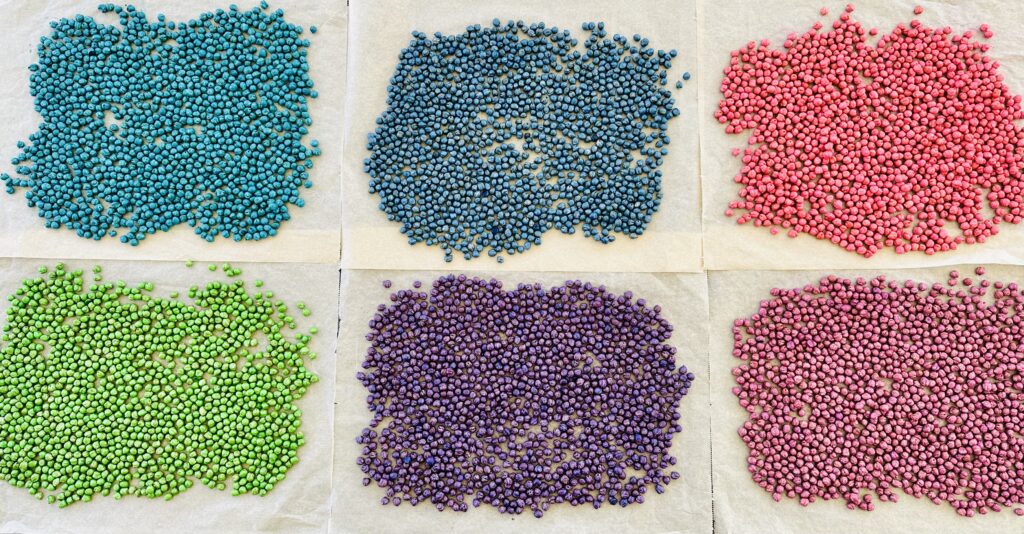
5. Play!
Once they’re dry, it’s time to dump them into your sensory bin and let the fun begin.
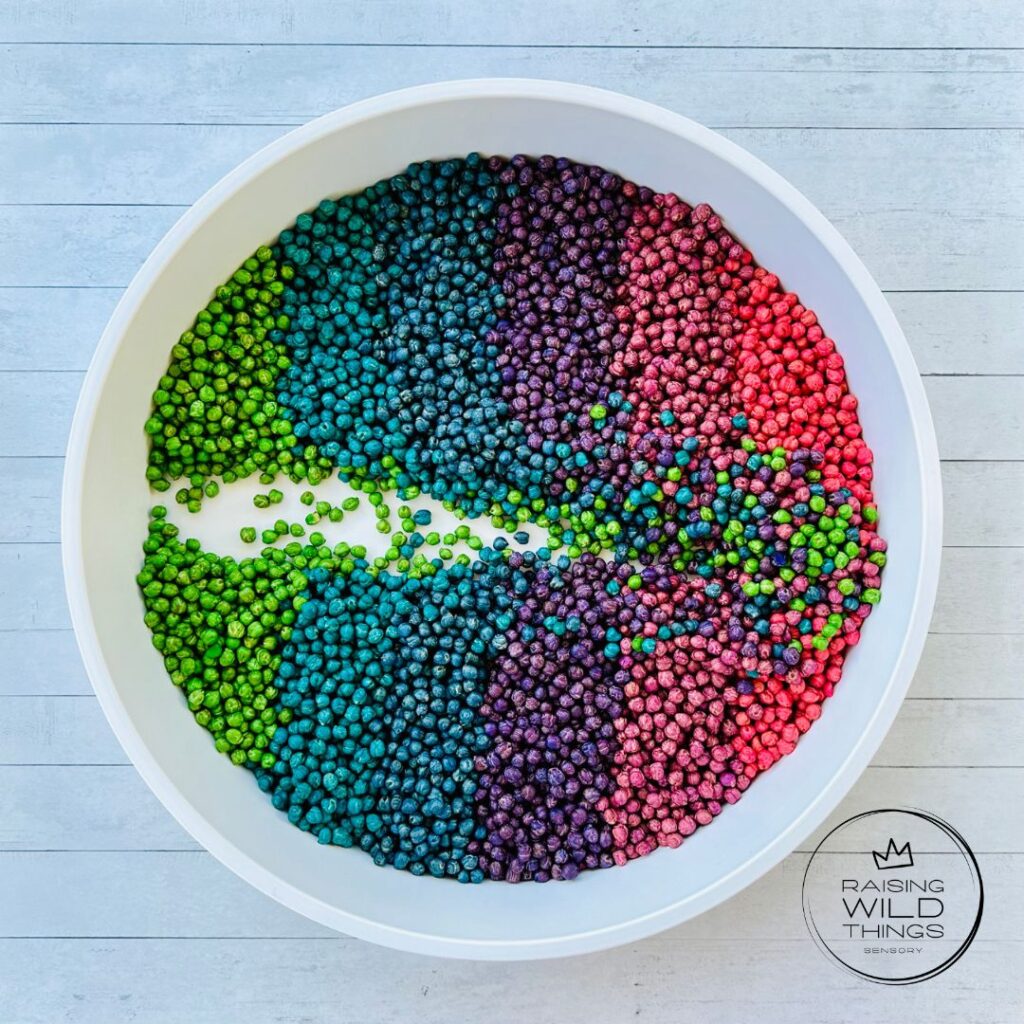
I mean, how easy is that? The colors are mesmerizing, and the tactile feel of the chickpeas adds so much richness to sensory play.
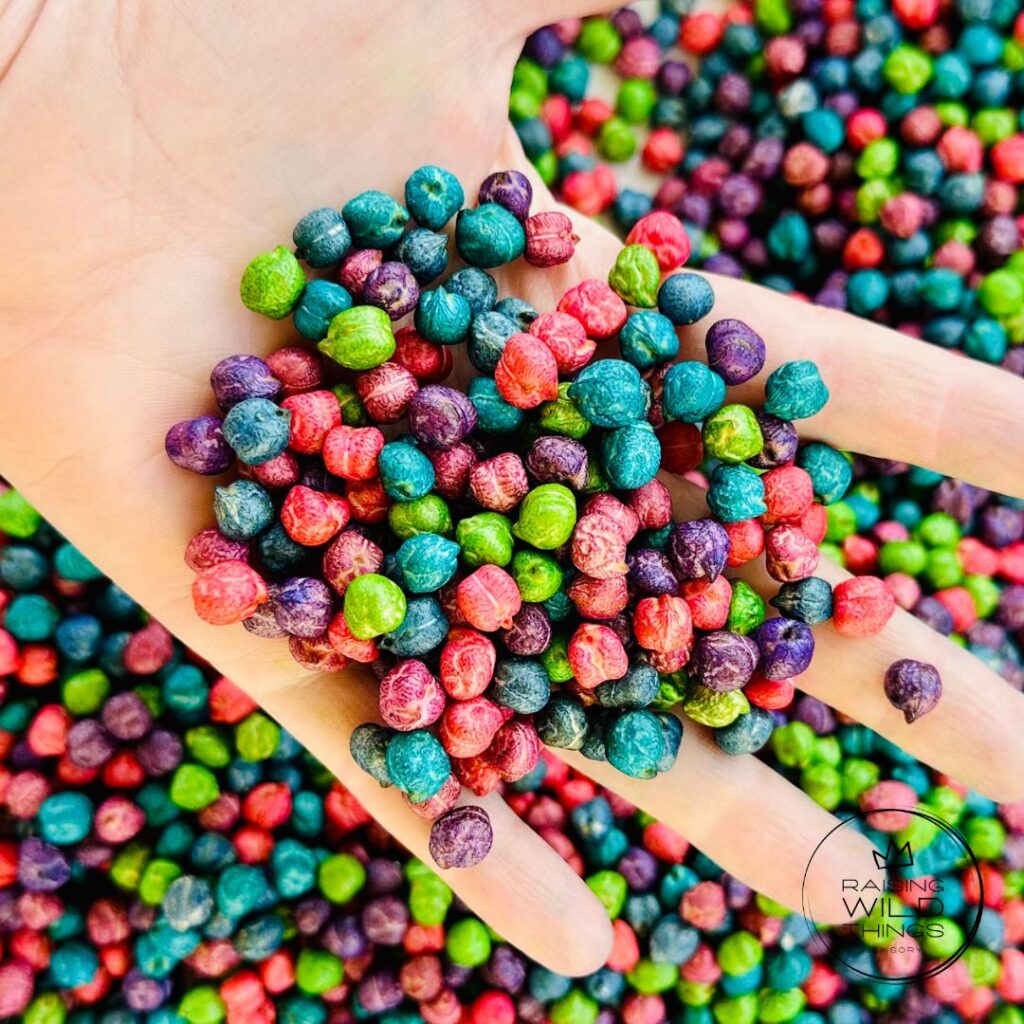
Creative Play Ideas with Dyed Chickpeas
Alright, you’ve got your colorful chickpeas—now what? Sensory bins are just the beginning! There are so many creative ways to incorporate dyed chickpeas into playtime. Here are three fun ideas to get you started:
1. Treasure Hunt
Bury small toys or figurines in a sensory bin filled with your rainbow chickpeas. Let your kids dig through the beans to find hidden “treasures.” It’s like a mini excavation site, and the added weight of the chickpeas makes it extra fun to scoop and dig.
2. Scoop and Pour Station
Set up a sensory table with scoops, funnels, bowls, and different containers. Kids love transferring the chickpeas from one container to another. This not only keeps them entertained for a long time, but it also helps improve their fine motor skills.
3. Color Sorting
If you dye your chickpeas in different colors, turn it into a color-sorting activity. Provide matching-colored bowls or cups, and let your kids sort the chickpeas by color. It’s a sneaky way to introduce color recognition and sorting skills, all while they think they’re just playing!
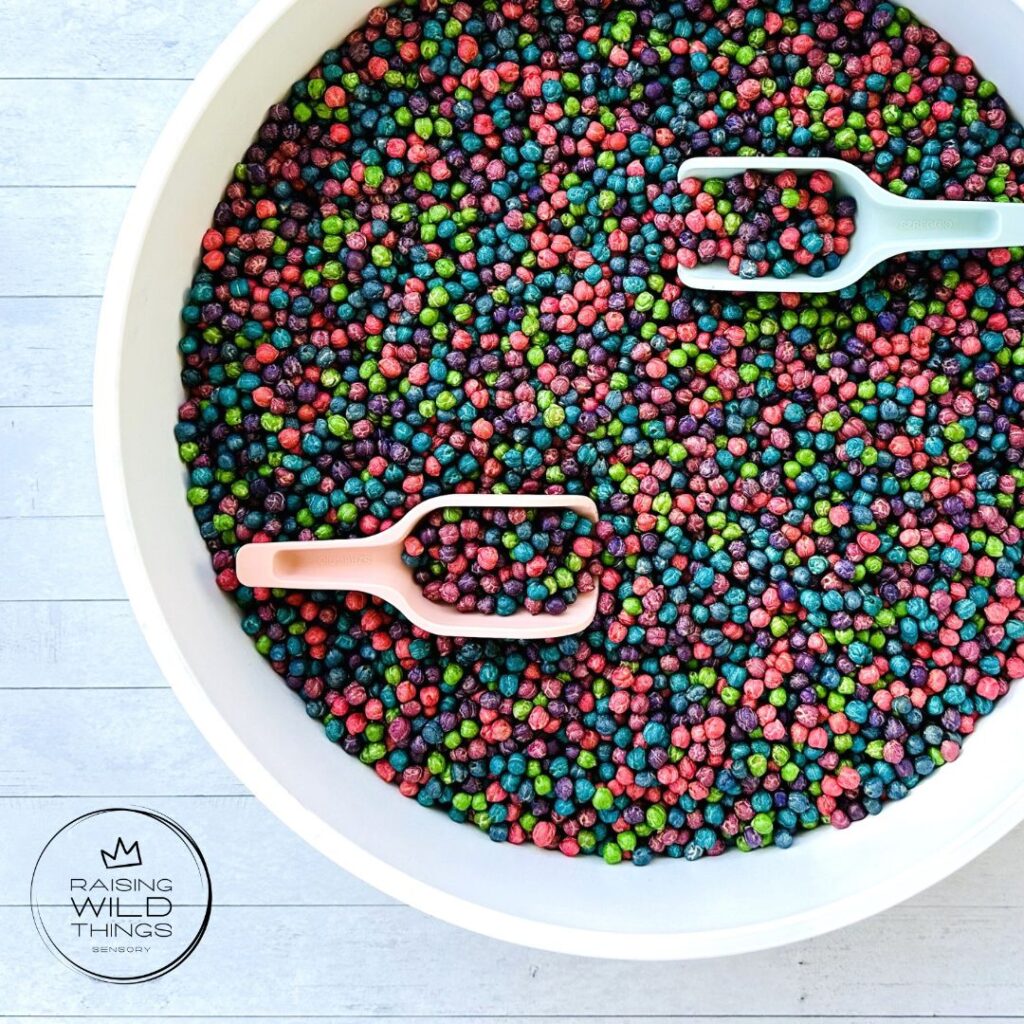
How to Store Your Dyed Chickpeas
Wondering how to keep your beautiful, vibrant chickpeas around for future play? Don’t worry, it’s super easy! Once you dye your chickpeas and they are completely dry, just toss them into an airtight container or Ziplock plastic bag. As long as you store them in a cool, dry place, they’ll last for years.
Pro tip: I like to use large, bulk-sized storage containers and keep all my sensory fillers—dyed chickpeas, dyed rice, beans, and more—in one place. That way, whenever we’re ready for a new sensory bin, everything is organized and ready to go.


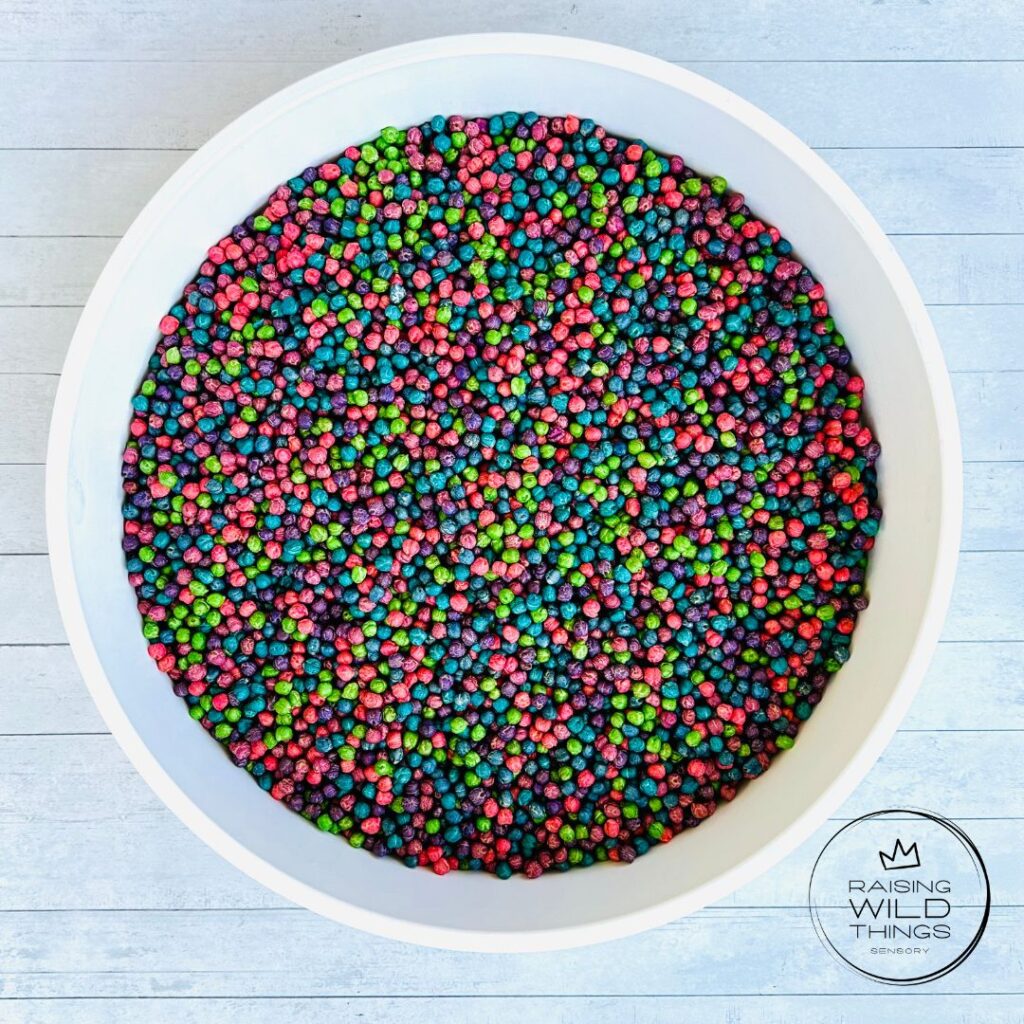
Why Chickpeas Are The Best for Sensory Play
You might be wondering—why dyed chickpeas? What’s so special about them? Let me tell you! Chickpeas are an incredible sensory bin filler, especially compared to other lighter fillers like rainbow rice or oats.
- Weight: Chickpeas are heavier than a lot of other fillers, which adds a unique tactile experience for kids. Kids can scoop, pour, and even run their hands through them for a fun sensory experience. The weight adds more feedback to their little hands, which is especially great for kids who need a bit more sensory input.
- Sound: Since chickpeas are heavier, they also make a fun clinking sound when they hit a container or when kids pour them from scoop to scoop. The noise is a huge hit with sensory seekers!
- Color: Once dyed, these colorful little beans are seriously gorgeous. Think rainbow-colored Skittles—but without the sugar rush!
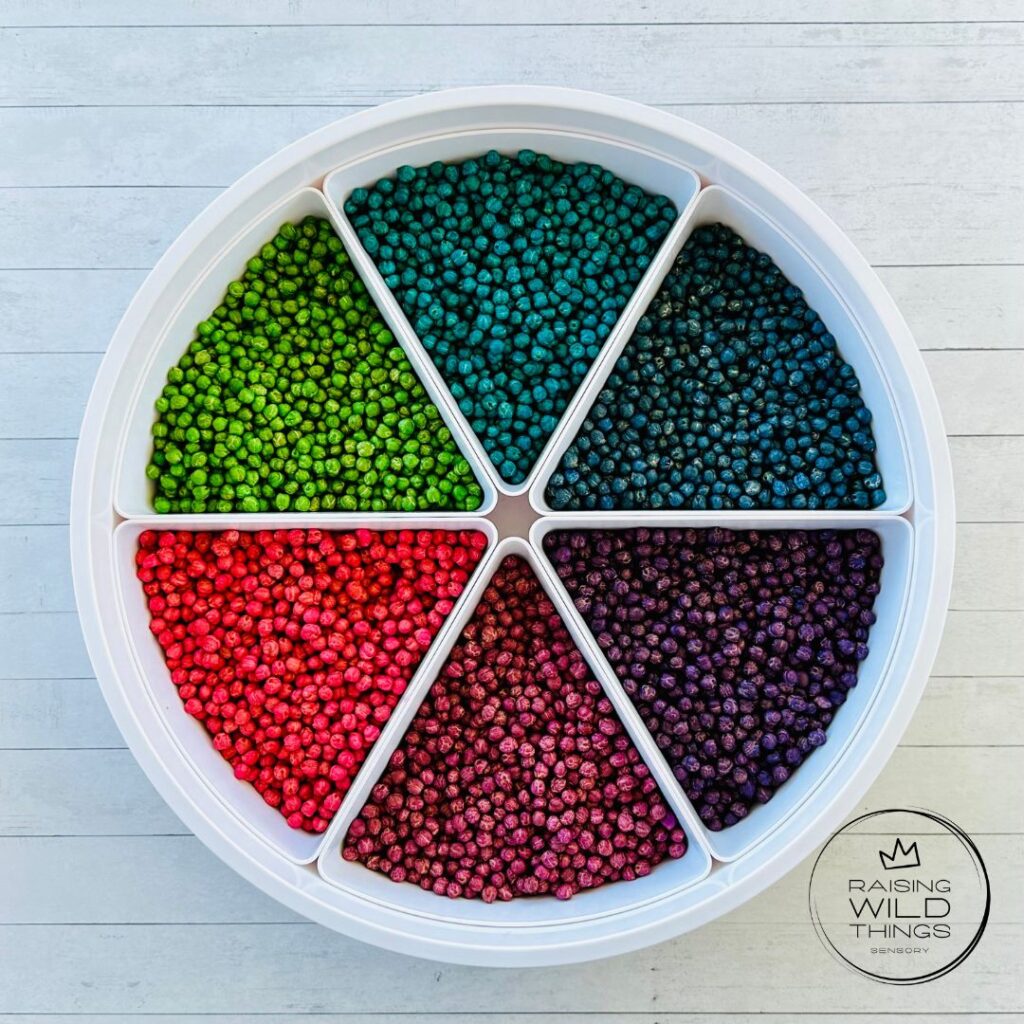
Pros and Cons: Vinegar vs. Rubbing Alcohol
When it comes to dyeing chickpeas, both vinegar and rubbing alcohol (or hand sanitizer which contains alcohol) will get the job done, but each has its own perks and drawbacks.
Vinegar is a more kid-friendly option since it’s non-toxic and food-safe, making it ideal for sensory play if you have little ones who still put things in their mouths. The smell is fairly mild and dissipates as the chickpeas dry, and any spills are easy to clean up. However, the downside to using vinegar is that it can take a bit longer for the chickpeas to dry—usually around 3-4 hours—and the colors may be slightly more muted compared to alcohol-based dyeing.
On the other hand, using rubbing alcohol and hand sanitizer to dye chickpeas offers faster drying times, typically within 2 hours, and tends to produce more vibrant, intense colors. The alcohol helps the food coloring absorb more thoroughly into the chickpeas, giving you those bright, bold shades. However, rubbing alcohol is not food-safe, so it’s important to supervise young children during playtime to ensure they’re not tasting the chickpeas. The alcohol also has a stronger odor compared to vinegar, but it evaporates quickly as the chickpeas dry, so it won’t stick around for long.
Both methods are effective to dye chickpeas, so it really comes down to what’s best for your family. If you’re working with toddlers who are still mouthing objects, vinegar is probably the safer option. If you’re short on time and looking for bright colors, rubbing alcohol or hand sanitizer might be your go-to.
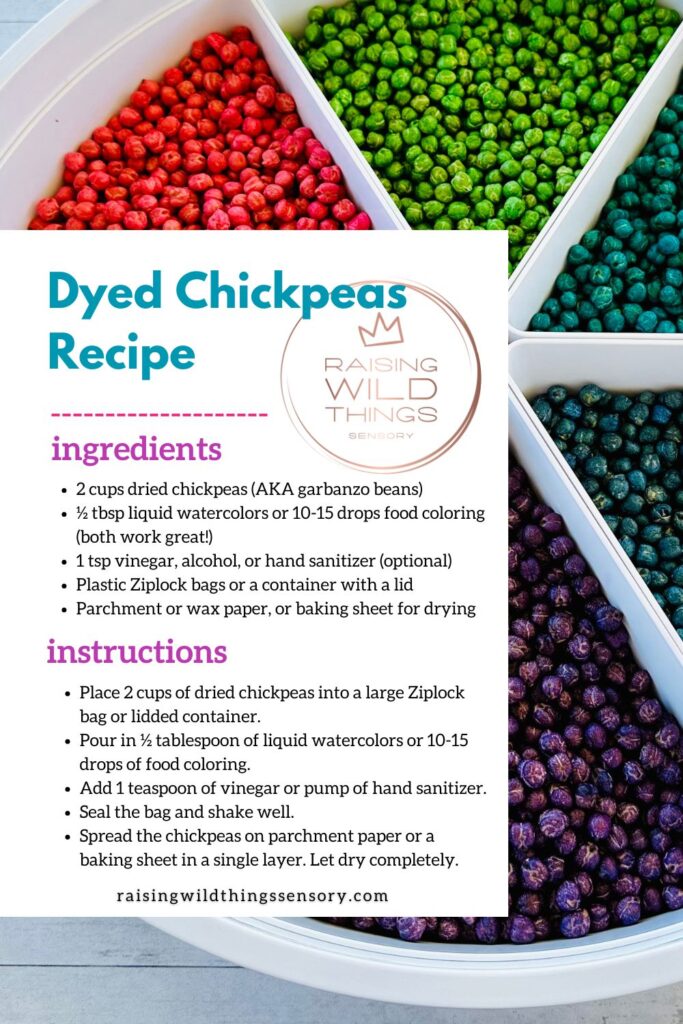
Why You’ll Love This
You will love learning how to dye chickpeas for sensory play. They are easy and quick to make, and also provide a ton of sensory benefits for kids. The tactile feel, weight, and sound make them a favorite for kids who seek sensory input, and let’s be honest, they’re gorgeous. Plus, they last forever if you store them properly, so it’s a super cost-effective way to create endless hours of play.
So, what are you waiting for? Grab a bag of chickpeas, some color, and let’s make some magic happen!
Recommended
- 17 Recipes: The Best DIY Sensory Bin Fillers
- How to Dye Chickpeas for Sensory Play
- How To Dye Rice To Make Rainbow Rice
- How To Dye Pasta Noodles For Sensory Play
- How to Make Jello Blocks for Sensory Play
- How to Make Taste-Safe Chia Seed Sensory “Slime”
- How To Make Edible “Mud” Playdough For Sensory Play
- How To Make Edible Dirt For Sensory Play
- How To Make The Best Taste-Safe Kinetic Sand
- How To Make Taste-Safe Moon Dough For Sensory Play
- How to Make Taste-Safe Chia Seed Sensory Mud Slime
- How To Create Awesome Colorful Bubble Foam
- How to Make The Best 2 Ingredient Cloud Dough
- How to Make The BEST 2 Ingredient Edible Play Dough
- Guide To Sensory Bin Supplies You Need To Have

